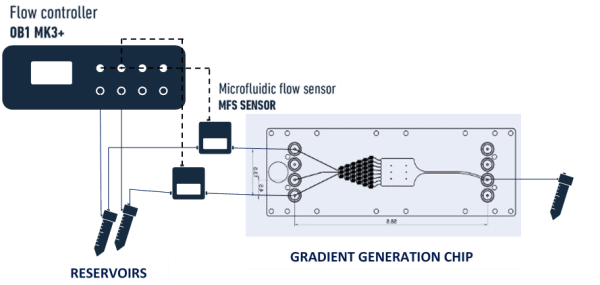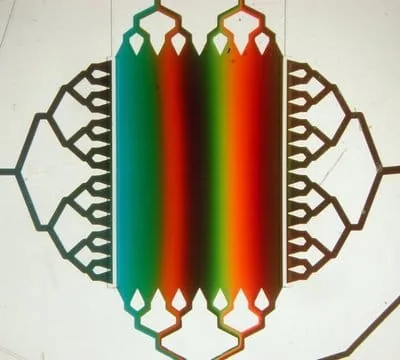Microfluidic concentration gradient pack
Set up and start your experiments right away
Smooth gradient thanks to the 6 stages of serpentine channels
Material transparency and wide gradient area for reaction monitoring
Concentration gradient generation
Creating a concentration gradient between two fluids in a microfluidic channel has never been easier using the concentration gradient pack for many possible applications like long-term cell investigations. This pack can also be used for applications such as drug development or chemotaxis observation to study biofilm formation.
Based on the Elveflow OB1 flow controller and a gradient generation chip, this highly customizable pack contains all the required parts for researchers to set up their concentration gradient experiment with high gradient stability and control. Microfluidic experts will offer you support during the installation of the microfluidic platform.
A standard steady-state concentration gradient pack contains two pumping channels to push the two fluids to mix through the gradient generator chip, creating a progressively incorporated liquid at the gradient area of the chip. The serpentine-shaped microchannels allow the mixing of the two fluids before they reach the gradient area of the chip.
The efficiency of the concentration gradient generation will be directly linked to the fluid’s properties and the flow rate inside the channels. Flow rates can be measured thanks to the two Elveflow flow rate sensors (MFS or BFS series).
Concentration gradient pack setup
An all-in-one pack guarantees good compatibility between the different instruments, allows you to start your experiment right away, is piloted by a single software and can be used for other different microfluidic applications. Therefore, this pack is the simplest way to set up a microfluidic concentration gradient experiment.

A concentration gradient pack typically contains:
- OB1 flow controller (Elveflow)
- 2x Flow sensor (MFS or BFS, Elveflow)
- Falcon reservoirs
- A gradient generation chip from microfluidic ChipShop
- All necessary accessories: tubing, connectors, filters, etc…
- Control and automation software (Elveflow)
Microfluidics concentration gradient principle
Regulated concentration gradients of biomolecules control many essential cell functions within the human body [1], such as immune response, wound healing, or embryogenesis [2, 3, 4].
Creating a gradient between a medium and a drug can allow one to precisely measure the drug’s effect on a specific entity depending on its concentration [5].
The composition of solutions can be directly measured at a specific point of the gradient by doing a colorimetric assay. The gradient is dynamic as it is possible to change its shape by changing the flow rates of each fluid inserted in the chip [6].
Creating a gradient is very useful for a lot of applications in chemistry, like the growth of crystals [7] or nucleation [8], and in biology, like growth cone guidance [9] or chemotaxis [10], for example.
References
- Alicia G. G. Toh, Z. P. Wang, Chun Yang; Engineering microfluidic concentration gradient generators for biological applications; Microfluid Nanofluid 2013, DOI 10.1007/s10404-013-1236-3
- Kothapalli CR, van Veen E, et al. (2011) A high-throughput microfluidic assay to study neurite response to growth factor gradients. Lab Chip 11(3):497–507
- Lin F (2009) A microfluidics-based method for analyzing leukocyte migration to chemoattractant gradients. Methods Enzymol 461:333–347
- Heo YS, Cabrera LM et al (2010) Dynamic microfunnel culture enhances mouse embryo development and pregnancy rates. Hum Reprod 25(3):613–622
- W. Siyan et al. / Journal of Pharmaceutical and Biomedical Analysis 49 (2009) 806–810
- N.L. Jeon, S.K.W. Dertinger, D.T. Chiu, I.S. Choi, A.D. Stroock, G.M. Whitesides, Generation of Solution and Surface Gradients Using Microfluidic Systems, Langmuir, 16 (2000) 8311-8316
- Aizenberg, J.; Black, A. J.; Whitesides, G. M. Nature 1999, 398, 495-498
- Aizenberg, J.; Black, A. J.; Whitesides, G. M. J. Am. Chem. Soc. 1999, 121, 4500-4509
- Song, H. J.; Poo, M. M. Curr. Opin. Neurobiol. 1999, 9, 355-363
- Wilkinson, P. C. J. Immun. Methods 1998, 216, 139-153
Why use microfluidics for concentration gradient generation?
Microfluidics is an efficient way to decrease the amount of potentially valuable samples needed for an experiment, reducing the costs of experiments.
Decreasing time and length scale is crucial for drug development and chemotaxis studies. Studying one cell or particle at a time in a microfluidic channel with very well-tuned fluid properties is also possible.
Microfluidics make static concentration gradients more stable on long-term scales than gradients in macroscale experiments.
Other microfluidic chips can be easily added before or after the gradient generation chip to create a more integrated platform for complex experiments.

1. Cooksey, G.A., Sip, C.G., Folch, A. (2009). A multi-purpose microfluidic perfusion system with combinatorial choice of inputs, mixtures, gradient patterns, and flow rates. Lab on a Chip, 9(3), 417-26
Customize your concentration gradient microfluidics
The gradient chip provided by Microfluidics ChipShop is available in Cyclic Olefin Copolymer (Topas COC) or polystyrene (PS) materials; the material can also be hydrophilized to improve capillarity-induced flow.
More pumping channels for the OB1 flow control pump and flow rate sensors can be added to the pack.
The MFS can be replaced with Coriolis flow sensors to improve the flow control even more.
Bubbles can be a problem when creating good gradients. A bubble remover can be added to the pack to be placed before the microfluidic chip, which can remove any bubbles that pass through it.
You can contact our experts to answer questions about this concentration gradient pack and how it can match your specifications.
– Check our other Packs for various applications –
How can we help in your experiment?
The Packs applications are still under development, so we are not able to give you the tips or troubleshooting advice that we usually give in our user guides and application notes for the possible challenges you could face for a specific application experiment. That being said, we can always guarantee reliable and high precision microfluidic flow control. Our microfluidic instruments are high performance, versatile and user-friendly. Our experts will bring support and expertise during the setup and the implementation of the pack.
Can the pack be customized based on my specific application?
Yes! Our experts will establish which instruments are best suited for your application, such as the type of flow sensor or the number of flow controller channels you need to perform your experiment. Send us a message:
Can I buy individual instruments?
You can order our instruments on the product section of our website.